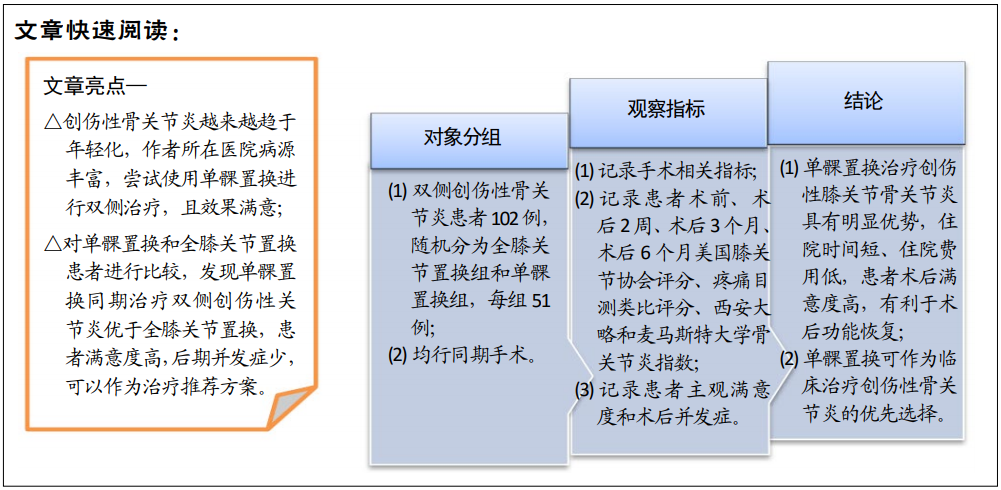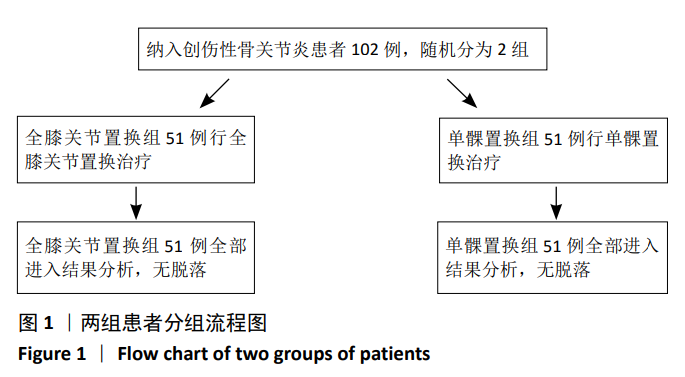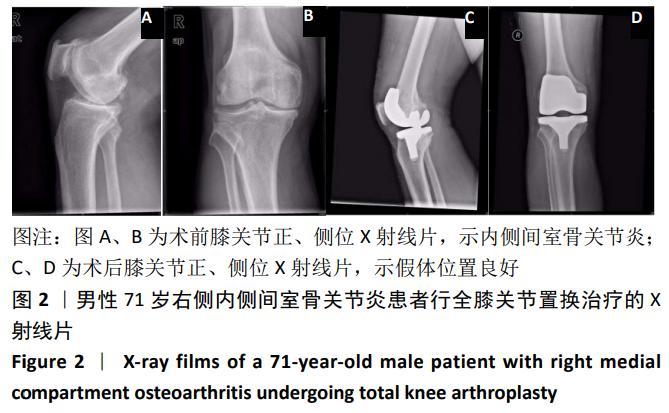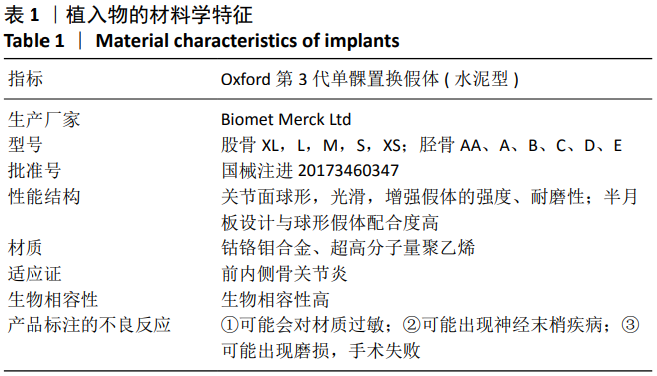[1] 吴红. 中医辩证治疗膝骨性关节炎的网状Meta分析[J]. 中西医结合心血管病电子杂志, 2018,23(6):193.
[2] 梅轶芳. 中国骨关节炎流行病学研究现状及规范[J]. 中国实用内科杂志, 2019, 39(8): 663-665.
[3] NIU J, CLANCY M, ALIABADI P, et al. Metabolic syndrome, its components, and knee osteoarthritis: the framingham osteoarthritis study. Arthritis Rheumatol. 2017;69(6):1194-1203.
[4] 张晓盈,彭嘉婧,刘传慧,等.骨关节炎患者用药治疗现状的全国多中心大样本现场调查[J]. 北京大学学报(医学版), 2018,50(6): 1044-1048.
[5] GOH GS, RAZAK HR, TAY DK, et al.Unicompartmental knee arthroplasty achieves greater flexion with no diference in functional outcome, quality of life, and satisfaction vs total knee arthroplasty in patients younger than 55 years. A propensity score-matched cohort analysis. J Arthroplasty. 2018;33(2):355-361.
[6] KLEEBLAD LJ, VAN DER LIST JP, ZUIDERBAAN HA, et al. Larger range of motion and increased return to activity, but higher revision rates following unicompartmental versus total knee arthroplasty in patients under 65: a systematic review. Knee Surg Sports Traumatol Arthrosc. 2018;26(6):1811-1822.
[7] 宋伟,朱振国,徐进,等. 单髁置换术与胫骨高位截骨术治疗膝关节骨性关节炎的荟萃分析[J]. 中国矫形外科杂志,2018,26(21): 1962-1968.
[8] 王亮,伍骥,郑超,等. 单髁与全膝置换治疗老年单间室骨关节炎比较[J]. 中国矫形外科杂志,2017,25(15):1372-1377.
[9] PEERSMAN G, SLANE J, VUYLSTEKE P, et al. Kinematics of mobile-bearing unicompartmental knee arthroplasty compared to native: results from an in vitro study. Arch Orthop Trauma Surg. 2018;137(11): 1557-1563.
[10] ANOUSHIRAVANI AA, SAYEED Z, EL-OTHMANI MM, et al. Single-stage revision total knee arthroplasty in the setting of periprosthetic knee infection: indications, contraindications, and postoperative outcomes. Instr Course lect. 2017;66:235-247.
[11] MAXWELL R, JOHNSTON A, LEES D, et al. Knee OUTcome Study: A Comparison of the Patient Perceived Outcome between High Tibial Osteotomy, Unicompartmental and Total Knee Arthroplasty for Medial Compartment Osteoarthitis in Men under age 55. Orthop J Sports Med. 2017;5(5_suppl5):2325967117S0016.
[12] 李程,张骏,李强,等. 全膝关节置换术与单髁置换术治疗膝关节单间室骨关节炎的疗效比较[J]. 中华解剖与临床杂志,2017,22(2): 121-126.
[13] 王春波,王丹,曹名卓,等.温经活血外用药穴位贴敷联合关节腔内注射玻璃酸钠治疗膝骨关节炎的临床疗效及血清IL-4和s IL-4R的介导作用[J].中国中医基础医学杂志,2019,25(5): 671-673.
[14] 王春生, 靳振岭, 张子琦, 等. 新版KSS评分系统的试应用及分析[J]. 中国矫形外科杂志, 2017, 25(1):33-37.
[15] 国延军,董建龙,刘堃,等.中药熏洗配合冲击波治疗膝骨关节炎合并鹅足滑囊炎的临床观察[J].中华中医药杂志,2019,34(10): 4962-4965.
[16] 李阳杰,孙奇峰,邓传超,等. 牛津膝关节评分量表应用于国内东北地区膝骨关节炎的信度和效度分析[J]. 实用骨科杂志,2019, 25(10):936-940.
[17] 蒋东方,廖瑛.软骨下骨在创伤性骨关节炎中的研究进展[J]. 医学综述,2018,24(15):3013-3017.
[18] 赵娜,康利宝.创伤性膝骨关节炎患者血清IL-6,TNF-α,瘦素水平表达与影像学K-L分级的相关性[J].现代检验医学杂志,2019,34(5): 139-142.
[19] ADRAVANTI P, SALVO ED, CALAFIORE G, et al. A prospective, randomized, comparative study of intravenous alone and combined intravenous and intraarticular administration of tranexamic acid in primary total knee replacement. Arthroplasty Today. 2017;4(1):85-88.
[20] MALHOTRA R. Total knee replacement or non-surgical therapy for osteoarthritis of the knee? Natl Med J India. 2016; 29(1):25-26.
[21] 王昕,胡龙,王雄,等. 同期或分期全膝关节置换术治疗高龄双膝关节骨关节炎的疗效[J]. 中国老年学杂志,2017,37(5):1201-1203.
[22] 戚爱清,宋长志,纪标,等.同期和分期双侧全膝关节置换术治疗双膝骨性关节炎的疗效和安全性研究[J].临床和实验医学杂志, 2016,15(3):250-253.
[23] 袁溢霖,杨伟毅,潘建科,等. 单髁置换术与全膝置换术围手术期失血量比较[J]. 中国矫形外科杂志,2018,26(23):2151-2156.
[24] SCHROER WC, BARNES CL, DIESFELD P, et al. The oxford unicompartmental knee fails at a high rate in a high-volume knee practice. Clin Orthop Relat Res. 2013; 471(11):3533-3539.
[25] 刘晓东,凃意辉.膝关节单髁置换术的临床应用进展[J].中华关节外科杂志,2010,4(6):804-808.
[26] 孙康,田少奇,张积华,等. 膝关节单室置换的近期疗效[J]. 中华骨科杂志,2009, 29(7):648-652.
[27] Choy WS, Kim KJ, Lee SK, et al. Mid-term results of oxford medial unicompartmental knee arthroplasty. Clin Orthop Surg. 2011;3(3): 178-183.
[28] 马广文,尹宗生,黄斐,等.单髁置换术治疗膝关节内侧间室骨关节炎初期疗效[J]. 中国修复重建外科杂志, 2014,28(10): 1208-1211.
[29] PONGCHAROEN B, RUETIWARANGKOON C. Does tranexamic acid reduce blood loss and transfusion rates in unicompartmental knee arthroplasty? J Orthop Sci. 2016; 21(2): 211-215.
[30] OLLIVIER M, ABDEL MP, PARRATTE S, et al. Lateral unicondylar knee arthroplasty (UKA): contemporary indications, surgical technique, and results. Int Orthop. 2014;38(2):449-455.
[31] Ko YB, Gujarathi MR, Oh KJ. Outcome of unicompartmental knee arthroplasty: a systematic review of comparative studies between fixed and mobile bearings focusing on complications. Knee Surg Relat Res. 2015;27(3):141-148.
[32] Philip WD, Barbier J, Luyckx T, et al. Outcomes of a fixed-bearing, medial, cemented unicondylar knee arthroplasty design: survival analysis and functional score of 460 cases. J Arthroplasty. 2018;33(9): 2792-2799.
[33] BEHREND H, GIESINGER K, GIESINGER JM, et al. The “forgotten joint” as the ultimate goal in joint arthroplasty: validation of a new patient-reported outcome measure. J Arthroplasty. 2012;27(3): 430.
[34] WALDSTEIN W, KOLBITSCH P, KOLLER U, et al. Sport and physical activity following unicompartmental knee arthroplasty: a systematic review. Knee Surg Sports Traumatol Arthrosc. 2017;25(3):717-728.
[35] 李帅妙,杨支兰,许娟,等.养老机构膝骨关节炎患者的心理弹性状况及影响因素[J].中国当代医药,2019,26(5):191-195.
[36] MCCONNELL J, DILLON J, KINNINMONTH A, et al. Blood loss following total knee replacement is reduced when using computer- assisted versus standard methods. Acta Orthop Belg. 2012;78(1): 75-79.
[37] 王方兴,薛华明,马童,等.人工单髁关节置换术治疗超高龄膝关节骨关节炎患者的近期疗效[J].中国修复重建外科杂志, 2019, 8(33):947-952.
[38] 雷堃,张文,高磊,等.膝关节单髁置换术治疗膝关节内侧间室骨关节炎的近期疗效评价[J].中华骨与关节外科杂志,2019,12(3): 201-205.
[39] ODE Q, GAILLARD R, BATAILLER C, et al. Fewer complications after UKA than TKA in patients over 85 years of age: A case-control study. Orthop Traumatol Surg Res. 2018;104(7):955-959. |








